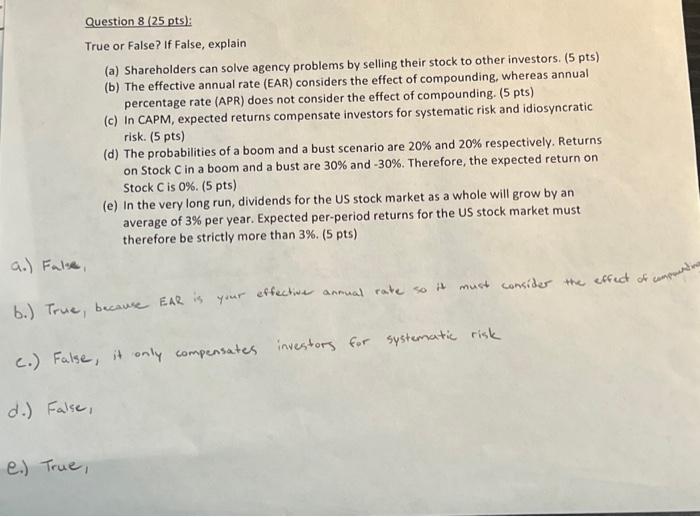Answered step by step
Verified Expert Solution
Question
1 Approved Answer
Question 8 (25 pts): True or False? If False, explain (a) Shareholders can solve agency problems by selling their stock to other investors. (5 pts)
Question 8 (25 pts): True or False? If False, explain (a) Shareholders can solve agency problems by selling their stock to other investors. (5 pts) (b) The effective annual rate (EAR) considers the effect of compounding, whereas annual percentage rate (APR) does not consider the effect of compounding. (5 pts) (c) In CAPM, expected returns compensate investors for systematic risk and idiosyncratic risk. (5 pts) a.) False, b.) True, because EAR is your effective annual rate so it must consider the effect of compounding d.) False, (d) The probabilities of a boom and a bust scenario are 20% and 20% respectively. Returns on Stock C in a boom and a bust are 30% and -30%. Therefore, the expected return on Stock C is 0%. (5 pts) (e) In the very long run, dividends for the US stock market as a whole will grow by an average of 3% per year. Expected per-period returns for the US stock market must therefore be strictly more than 3%. (5 pts) C.) False, it only compensates investors for systematic risk e.) True,
Part B and C are correct so explain why Part A and D are false and then explain why Part E is true

Step by Step Solution
There are 3 Steps involved in it
Step: 1

Get Instant Access to Expert-Tailored Solutions
See step-by-step solutions with expert insights and AI powered tools for academic success
Step: 2

Step: 3

Ace Your Homework with AI
Get the answers you need in no time with our AI-driven, step-by-step assistance
Get Started


